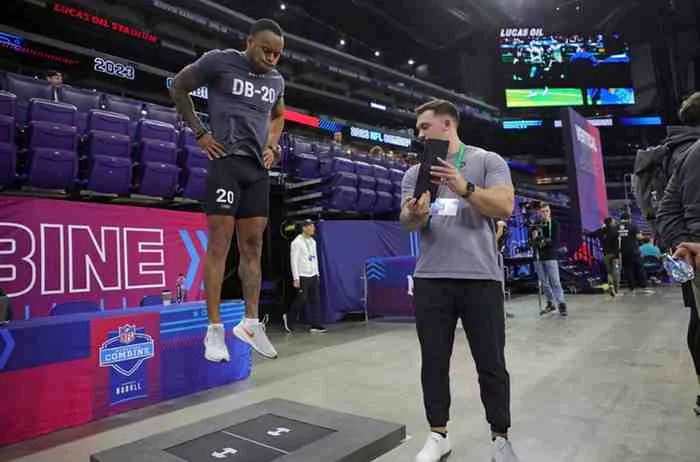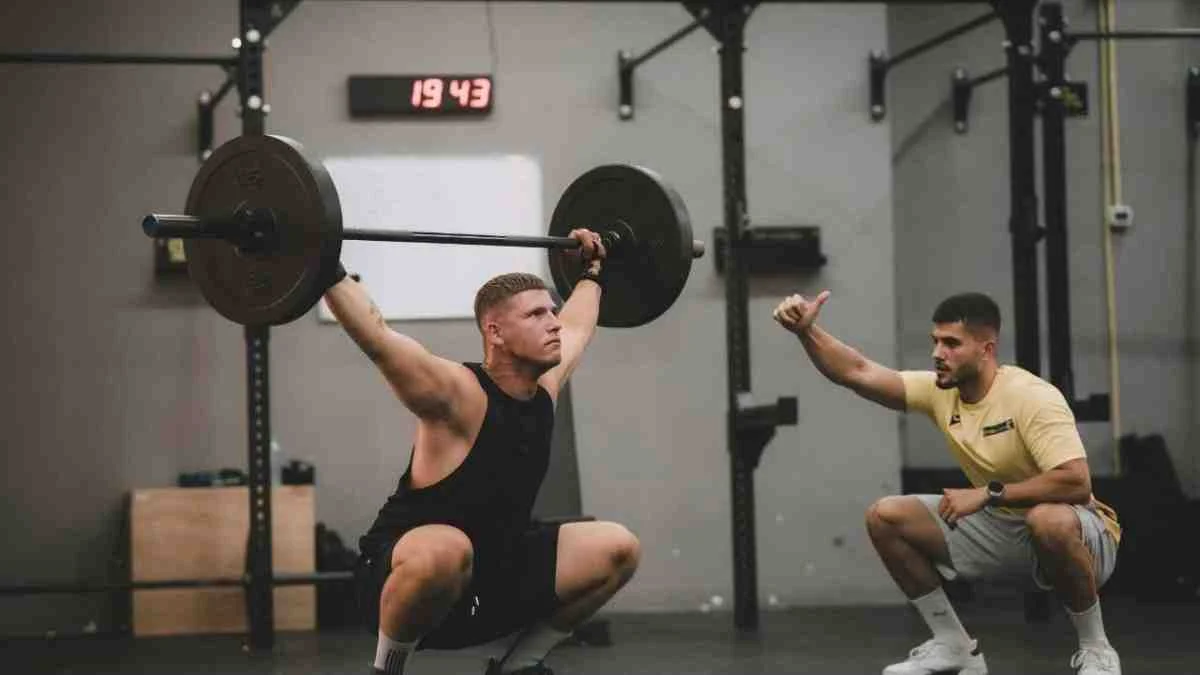[mashshare]
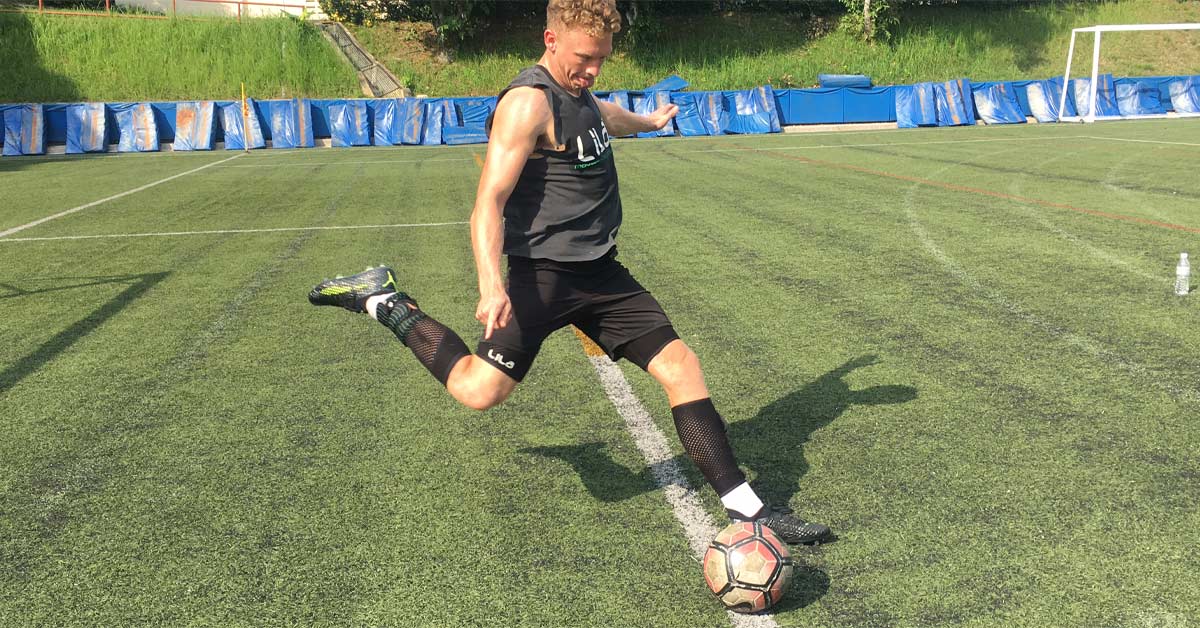
We typically think of a warm-up as a means to prepare for an event or sport, but wearable resistance (WR) has brought a new dimension to this activity. In a new study out of Argentina, a group of provincial soccer players that warmed up with WR improved many key athletic qualities (speed, power, and repeated sprint ability) more than the group that performed the warm-up unloaded.
I want to share this program with you as a practical example of how to program with WR to improve speed, as it is an evidence-based approach. Before I unpack these findings and discuss the training program used to make these changes, however, I want to back up the bus a little.
The finding that using WR in a warm-up improves speed does not come as a surprise, as my previous articles on this site explained that WR is a form of movement-specific resistance training. The innovation around this technology is that resistance training is part of what you do, and not separate from what you do. Therefore, it’s not surprising that a well-structured warm-up will result in physiological adaptation when you bring WR into play.
The Argentine study, “The Effects of Warming Up with Lower Body WR on Physical Performance Measures in Soccer Players over an 8-Week Training Cycle,” will be published in a forthcoming edition of the Journal of Strength and Conditioning Research.
SAID and Redefining the Function of a Warm-Up
The SAID principle (Specific Adaptation to Imposed Demands) provides insight into how the human body adapts to the stressors placed upon it, whether these are mechanical, metabolic, neural, etc. In the case of a warm-up, if we add load to certain movement patterns, the body will adapt accordingly.
One of the interesting observations of the loaded versus unloaded groups in the study was the between-group differences in the horizontal jump but not the vertical jump. Guess what? The warm-up involved concerted doses of horizontal jumping and very little vertical oriented jumping (i.e., SAID). In short, applying the principle of specificity, movement choices in your warm-up determine adaptation.
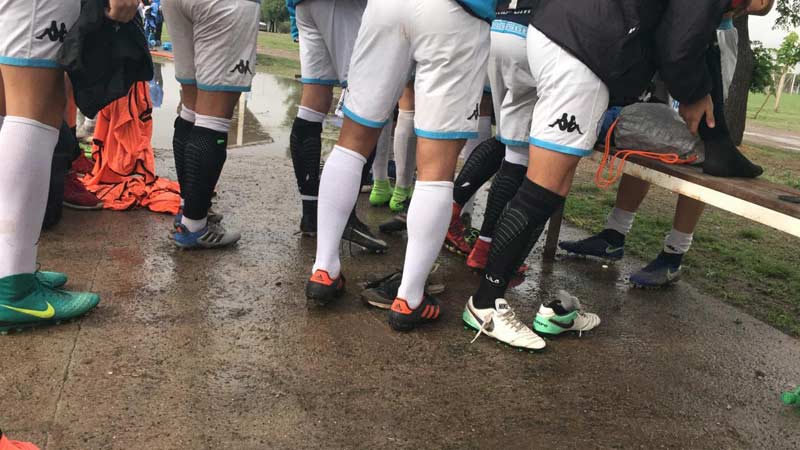
Recognizing the SAID principle in tandem with the addition of WR in a warm-up means that we can redefine the function of a warm-up, if we so wish. This is important when we are in-season and time-poor, particularly for sports with congested schedules such as baseball, basketball, European soccer, etc.
Wearable resistance lets us improve, or at least maintain, important in-season athletic qualities by simply planning a well-structured warm-up. Share on XWe may now have the means to improve, or at the very least maintain, important athletic qualities in-season—speed, power, stamina, change of direction—by simply engaging in a well-structured warm-up.
What Is a Well-Structured Warm-Up?
In general, we think of a warm-up adhering to the RAMP protocol, where exercises are chosen to raise heart rate and muscle temperature, activate and mobilize the musculo-articular system, and potentiate and prime athletes specific to their event or sport. Very little changes when players use WR, although you might want to pay more attention to the movement patterns you want to improve.

WR as a strength training tool has another important differentiator: you’re training movement more than muscles, which is typical with more traditional gym-based resistance training. Case in point, if you’re seeking improvements in lateral ability, you need to ensure that the exercise, drill, or movement selection for your warm-up includes a solid dose of these resisted movements. If you want to improve change of direction (COD) ability, include COD movements specific to your sport in the warm-up.
The Argentine Soccer Study
The first thing to note is that the study used an on-field warm-up protocol, applied with elite soccer players who had won the National U17 competition the previous year. Players were baseline tested on speed (5m and 10m sprint times), vertical and horizontal leg power, and repeated sprint ability. Next, athletes were matched in pairs based on speed. After that, the researchers randomly allocated players either to a WR-loaded group or an unloaded-control group (a matched-pair, randomized control design).
The loaded group warmed up with Lila Exogen calf sleeves. From this point, both groups did exactly the same warm-up, only one group was using WR. After eight weeks, the players were retested. As a side note, it’s very easy to do WR research as it becomes part of what you do.
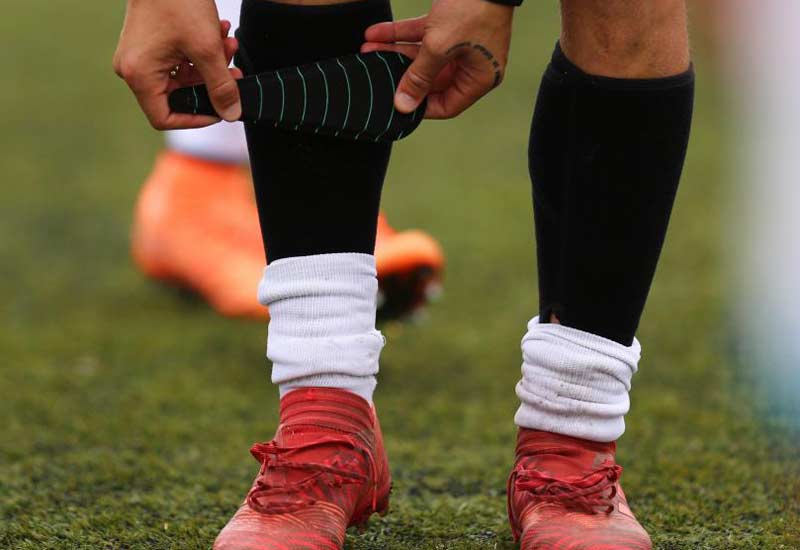
The protocol that effected statistically significant changes in speed was the one that used WR calf sleeves only. Why calf sleeves? For the answer, please refresh your grey matter on how load and placement of load effects rotational inertia. As a quick recap, the further a load is from the axis of rotation (e.g., the hip), the greater rotational inertia or the greater resistance to angular motion. When loads are further from the axis of rotation, the muscles across the hip and knee must work harder to accelerate and decelerate the limbs.
Also, calf sleeves were chosen because the players’ average weight averaged ~70 kg (154 lb), and you can get up to 2% body mass (1.4 kg or 3 lbs) on the calves quite comfortably (i.e., 700 gm or 1.5 lb per leg). For heavier players, however, you need to consider using WR shorts and calf sleeves to achieve the required loading of the neuromuscular system.
In the study, the loading protocol involved a periodized schedule where magnitude and placement of load systematically increased over eight weeks of training. Researchers increased loads from 200 gm (7 oz) to 600 gm (21 oz-1.3lb) per leg. Also, load placement progressed from proximal (close to knee) to distal (further from knee). You can see proximal loading (400 gm-14 oz) of the calf sleeve in Image 4.
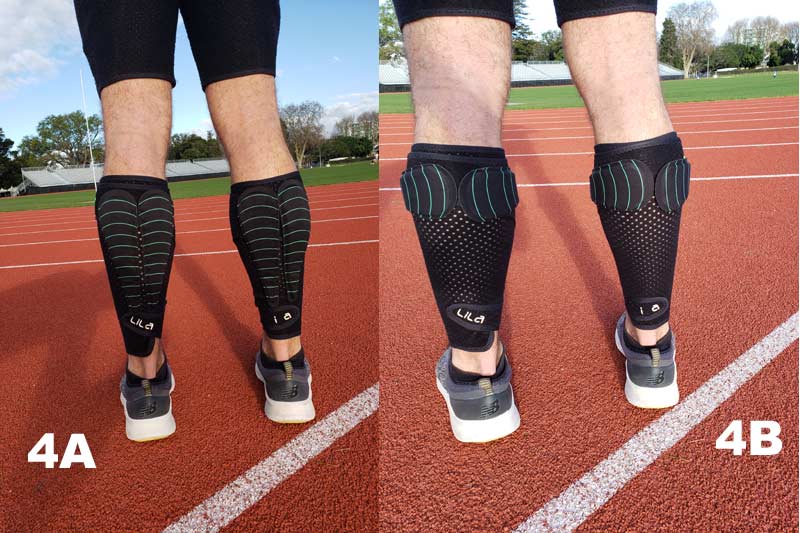
You can see that there are two different patterns, and both are proximal, or near the knee joint. Image 4b, however, shows more of the load closer to the knee and hip joint, offering slightly less overload.
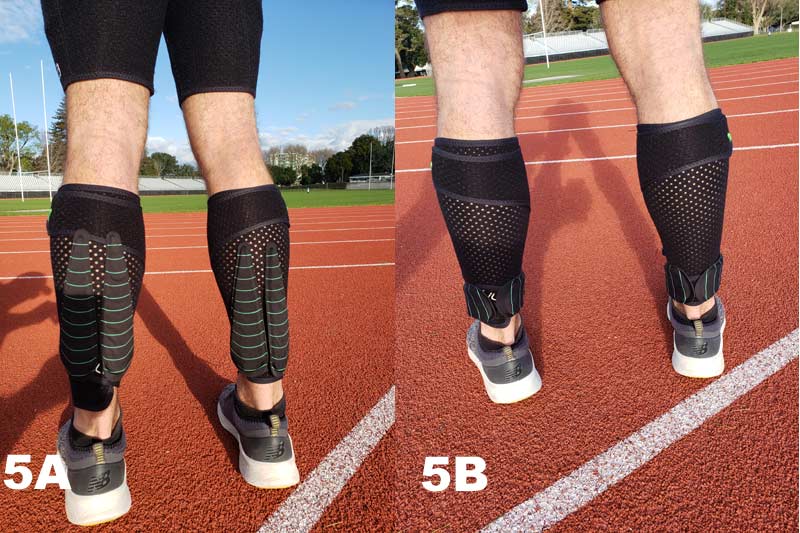
Image 5 shows distal loading of the calf sleeve, with Figure 5b more distally loaded given the orientation of the weights and therefore offering slightly more overload.
Finally, note that the load has been placed on the calf, or the rear side of the lower leg, and therefore is called a posterior loading pattern. The correct terminology is posterior proximal (Image4) and posterior distal (Image 5) loading patterns.
Taking Results to the Pitch
Table 1 below shows the loading protocol used in the warm-up for the soccer players. Progressive increments in weight are coupled with changes between proximal and distal loading over the eight weeks.
Also, note that there is some unloading every four weeks to coincide with testing in this case. Regardless of testing, however, standard practice with most forms of periodized planning recommends unloading every 3-4 weeks.
You also can see that the players in this study used the WR in their warm-ups three times per week, a decision based on their training status. With less well-conditioned athletes, consider reducing the frequency to two times per week until you’re sure they’re handling the additional overload.
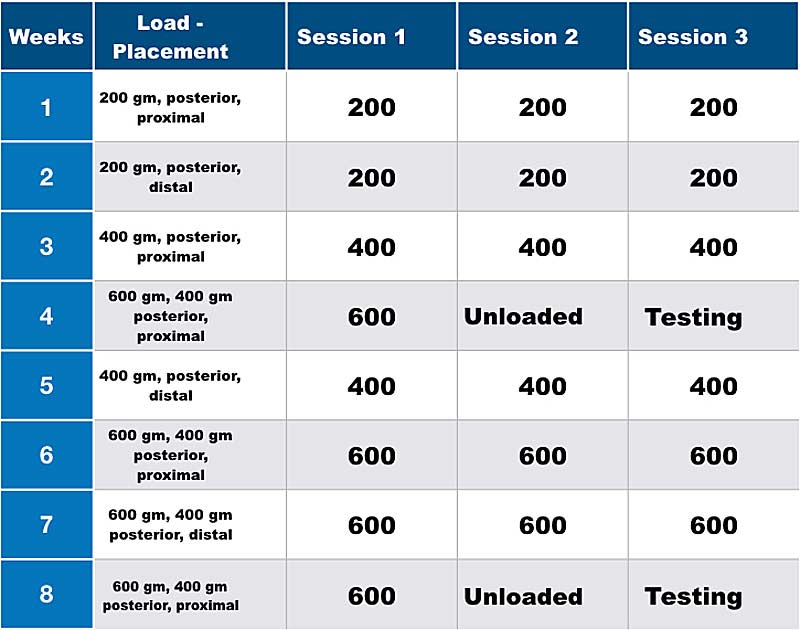
The on-field warm-up program used a typical RAMP approach consisting of 4-6 minutes of low to moderate running exercises combined with active stretching. This was followed by 10-15 minutes of technical drills with the ball and then 5-8 minutes of high-intensity accelerations, decelerations, changes of direction, plyometrics, and sprint exercises. Acceleration and speed were emphasized in the last exercise block.
Some of the locomotor patterns used in this block included:
- Cone zig-zag drill for 5m then 10m cuts left then right
- Sprint 10m, change direction, sprint back to start
- Fast feet 5m then 20m straight sprint
- Fast feet 5m, 10m sprint to a cone, change direction, sprint back to start
- Straight sprints for 20m gliding through cones
- Three bounds then 15m straight sprint
- Horizontal jump forward, backpedal 5m, sprint 20m
- Cone zig-zag 5m-H-jumps x 2-backpedal 5m-sprint 10m, change direction, sprint back to start
- Jumping over tall cones for 5m, sprint 15m, change direction, sprint back to start
As you can see, most of these exercises involved sprinting over 10-20m, with many changes of direction. As mentioned earlier, and according to the SAID principle, it’s no wonder the players experienced significant increases in their sprint times—they performed resisted sprint training 3 x 8 mins a week.
The players were typically in groups of five to six, which meant rest periods of 30-45 seconds between drills. At the end of the warm-up, players removed all loads from the calf and completed the practice with the sleeves on.
If players move WR light loads at speed, as they should toward the end of a warm-up, there will be considerable stress on the neuromuscular system. Share on XMost players will say they don’t notice the additional load and ask for more. In fact, RPE differs minimally between those using WR and those who do not. But trust me, if players move these light loads at speed (as they should toward the end of a warm-up), there will be considerable stress on the neuromuscular system. Therefore, stick to a systematic method of loading and unloading the important movements with WR to ensure adequate rest and recovery via a well-planned loading schedule.
Acknowledgment: Thanks to Anibal Bustos and Gustavo Metral for sharing information on the training of their soccer players
Since you’re here…
…we have a small favor to ask. More people are reading SimpliFaster than ever, and each week we bring you compelling content from coaches, sport scientists, and physiotherapists who are devoted to building better athletes. Please take a moment to share the articles on social media, engage the authors with questions and comments below, and link to articles when appropriate if you have a blog or participate on forums of related topics. — SF
[mashshare]



